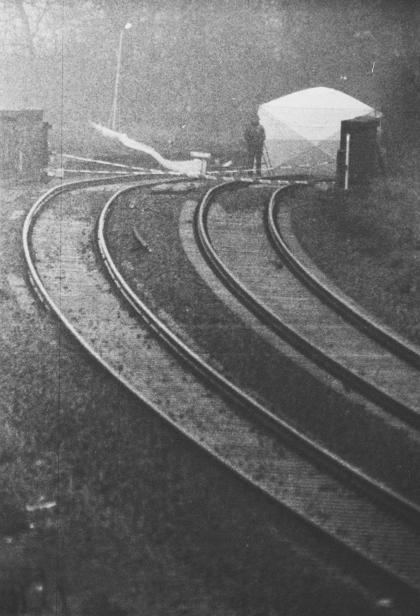James Bulger murder 20 years on: The grainy CCTV which shook Britain
As James Bulger was led through the Strand shopping centre in Bootle, Merseyside, on February 12 1993, there was nothing to hint at the dreadful murder he would later suffer.
It was a grainy CCTV image that appeared to show an innocent scene of a toddler walking hand-in-hand with a child.
But what the pictures in fact revealed turned out to be every parent's worst nightmare.
As James Bulger was led through the Strand shopping centre in Bootle, Merseyside, on February 12 1993, there was nothing to hint at the dreadful murder he would later suffer.
Moments earlier he had been seen on cameras walking with his mother Denise Bulger, now known as Denise Fergus.
Although occasionally dropping a few steps back, he followed his mother into a shop.
A short time later he was seen leaving alone, with his mother in pursuit soon after.
But instead of finding her son wandering nearby, it soon became apparent that James was missing.
The next day, his parents, Denise and Ralph, made an emotional appeal for help as detectives released CCTV images that would shock the nation.
They revealed the terrible reality that James had been abducted - by a child.
For reasons that are still unknown, Jon Venables and Robert Thompson, then aged 10, had led the toddler out of the shopping centre.
Shocking details of James's torture would later emerge during the trial.
The two boys, who were truanting from school, walked James around the streets of Liverpool for more than two miles, stopping occasionally to kick and punch him.
They told adults who intervened that he was their brother.
After taking him to a nearby railway line, they left his body on the tracks in the hope it would be destroyed by a train.
The toddler had been splattered with blue paint and his battered head lay surrounded by a pile of bricks.
His body was found two days later by children playing on a freight railway line - 200 yards from Walton Lane police station, Liverpool, and more than two miles from the Strand shopping centre.

Days later Venables and Thompson were arrested in connection with the murder of James, and later charged.
They were the youngest to be charged with murder in the 20th century.
In November that year, they were convicted following a 17-day trial at Preston Crown Court and ordered to be detained at Her Majesty's pleasure, the normal substitute sentence for life imprisonment when the offender is a juvenile.

Trial judge Mr Justice Morland told the pair they had committed a crime of "unparalleled evil and barbarity".
As shadow home secretary in 1993, future prime minister Tony Blair described the murder as "a hammer blow against the sleeping conscience of the nation".
Some 17 years later the country was awoken once again when Venables was returned to custody after allegedly breaching the terms of his release.
But details of his alleged crime were slow to emerge.
He had been controversially freed from prison in 2001 with a new identity, along with Thompson.
When they were released they were considered to be at serious risk of revenge attacks.
Dame Elizabeth Butler-Sloss, of the High Court Family Division, made an unprecedented court order banning publication of any information which could lead to the revelation of their new identities.
It was the court injunction preventing Venables's identification which meant details of the alleged breach were not immediately released.
The Ministry of Justice said the 27-year-old had been returned to custody "following a breach of licence conditions", adding: "There is a worldwide injunction in place that prohibits any reporting, including reporting on the internet, that could identify him or his location."
The Government faced growing calls to provide more information, including from the toddler's mother, Denise Fergus.
She said: "I am sick of them closing doors in my face. It's about time they started telling me what I think I should know. As James's mother I have a right to know."
But then-justice secretary Jack Straw said revealing further details would not be in the interests of justice.

Information about Venables's alleged crime could have led to his identification, putting Mr Straw in contempt of court.
The Attorney General's department issued a warning about the danger of publishing details which might make a fair trial impossible.
Lady Butler-Sloss herself stressed "the enormous importance of protecting his anonymity now and if he is released because those who wanted to kill him in 2001 are likely to be out there now".
Meanwhile, Mr Straw told the Commons: "If any offender on a life licence is charged with a serious further offence, a thorough review of the supervision must be carried out."
It later emerged a psychiatric assessment of Venables compiled prior to his release said he posed only a "trivial" risk to the public.

The account, seen by The Times newspaper, reportedly formed part of the legal case for Venables's release under a new identity.
On April 16 prosecutors were handed a police file over the allegations against Venables.
Despite news reports alleging he had been found with child sex abuse images on his computer, ministers were still only confirming that he faced "serious allegations".
It was not until June 21 2010, after a judge at the Old Bailey lifted media restrictions, that it could be reported Venables had been charged with downloading and distributing indecent images of children.
He was jailed for two years after pleading guilty to the charges and in 2011 he was refused parole.
Venables is expected to make a renewed bid for parole later this year.

 Yahoo News
Yahoo News 
